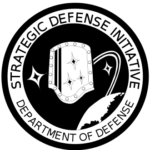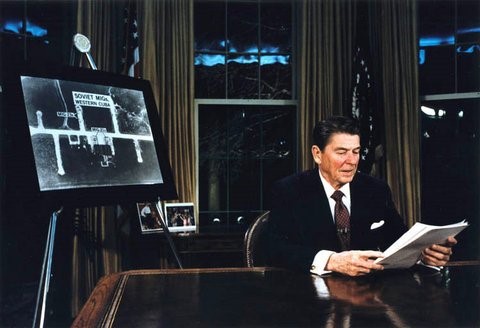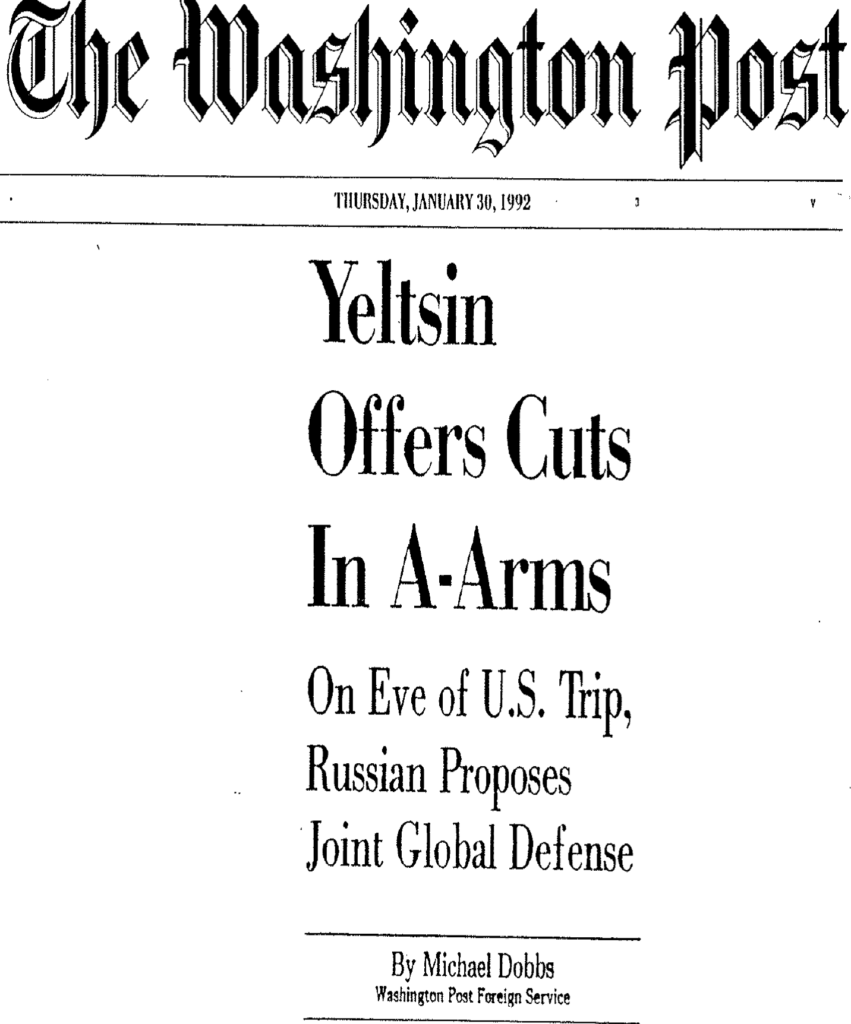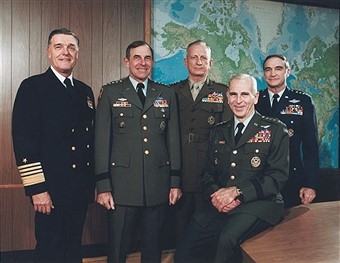“Wouldn’t it be better to save lives than to avenge them?” ~President Ronald Reagan … March 23, 1983
Last Friday was the 35th anniversary of President Ronald Reagan’s speech that defended his “Strategic Modernization Program” to reverse the atrophying military of the preceding decade — and in its final minutes launched his Strategic Defense Initiative (SDI), which Senator Ted Kennedy almost immediately called “Star Wars” to suggest seeking ballistic missile defenses was a fantasy that would lead to global instabilities and an end to arms control.
Leaders of the arms control community quickly echoed such claims. For example, click here for a Winter 1984/85 Foreign Affairs article by McGeorge Bundy, George F. Kennan, Robert S. McNamara, and Gerard Smith, “The President’s Choice: Star Wars or Arms Control,” p. 264.
These authors were longstanding arms control advocates, including in initiating and pursuing the Strategic Arms Limitation Talks (SALT) and its 1972 Anti-Ballistic Missile (ABM) Treaty, which limited our defenses to a single site in North Dakota to protect some of our Minuteman missile silos — and completely banned the development, testing and deployment of space-based, sea-based and even mobile land-based ABM systems that could defend the U.S. homeland.
This ban was consistent with the ABM Treaty’s purpose of prohibiting any ballistic missile defense (BMD) system than could protect Americans at home — and with assumed reciprocity also Soviet citizens. But the Soviets consistently violated the terms of the ABM Treaty and maintained extensive defenses throughout the Cold War, while we abandoned our only ground-based BMD site after it was operational for about six months in 1974.
We lacked any homeland defense against ballistic missiles until our first interceptors at Ft. Greely began operations in 2005. And prior to the Patriot-Scud battles of the 1991 Gulf War, we actually had to fight the arms control community to build defenses even to protect our troops against shorter range ballistic missiles, now called Theater Ballistic Missile Defense (TMD) systems. And they were not limited by the ABM Treaty, so long as they were not “tested in and ABM mode” that might protect the American homeland.
Arms control advocates apparently then viewed that Americans were most safe when most vulnerable and protected by a “mutual suicide pact” called Mutual Assured Destruction (MAD). The idea was that if the Soviets attacked us with nuclear weapons, then we would destroy them as well — and so we would both avoid the consequences of nuclear war.
President Reagan despised this MAD doctrine on moral and ethical grounds.
SALT never led to real limitations, let alone reductions — which is why President Reagan labeled his negotiations on strategic arms, Strategic Arms Reduction Talks, or START. When they began in 1982, he directed his negotiators to seek real reductions seriously, not just cosmetic arms control for arms control sake in the Cold War spirit of Détente as it had become vogue to be called.
Reagan famously said that his policy in dealing with the Soviets was “We win; they lose” — a claim much derided by the alleged cognoscenti of the time.
In any case, U.S. arms control proponents opposing Reagan’s SDI vision reflected the views of most of the international arms control community, Soviet leaders and others, who argued that SDI would create an arms race, particularly in space, and bring an end to the possibility of arms control agreements.
Most prominent among these criticisms was that the President’s interest in space-based defenses would lead to an arms race in space.
But, in fact, confronting the Soviets’ actual interests and their respect for American technology and technologists actually had the converse effect, as discussed below.
I took part in two activities last Thursday and Friday, celebrating this important history and its important consequences. The first activity on Thursday was a two-hour session at the Heritage Foundation, where I joined several other folks who have been intimately involved with this history to discuss our recollections and associated implications. Friday I joined a fellow Reaganite, Frank Gaffney, on his Secure Freedom radio program for an hour long interview. Both the Heritage event and the interview can be found by clicking here. In addition, please click here for my March 23rd Newsmax article which is an abridged version of today’s more complete message incorporating additional thoughts.
Back to the heart of today’s message, recall that President Reagan inherited a “hollow force,” as then Army Chief of Staff “Shy” Meyer called it — and also our atrophying Navy, our Air Force and especially our strategic systems. And he first focused on reversing those trends, particularly with his “Strategic Modernization Program,” to which I referred above.
That very important Strategic Modernization Program, begun almost immediately after he took office on January 20, 1981, was the most extensive topic of his March 23, 1983 speech, because it established the conditions from which he could then underwrite his “Peace through Strength” agenda, as he often argued. On this basis, he had begun his START negotiations in 1982 (essentially a year after a break between the Carter and Reagan administrations) and continued Intermediate Nuclear Forces (INF) negotiations begun in the later days of the Carter administration — but focused by President Reagan on achieving a complete ban of Soviet and U.S. INF arms.
Both negotiations eventually achieved the first arms control treaties ever actually to reduce nuclear arms, rather than just allegedly to limit their growth.
In October 1983, the Soviets walked out of all arms control negotiations, when we began deploying our INF Missiles in the homelands of five of our NATO allies — in response to the Soviet SS-20s that had begun operations in the late 1970s to threaten NATO.
The Soviets then sought (unsuccessfully) to undermine the re-elections of the leaders of these NATO allies—and especially the reelection of President Ronald Reagan. In what, in my opinion, was one of NATO’s finest moments, all leaders were re-elected. (BTW, note that the current high anxiety press buzz on Russian interference in our negotiations is obviously not about a new condition.)
After that 1984 failure to work their will in our elections — and those of our NATO allies, the Soviets were interested in returning to the negotiating table, and they made clear that their main target in the March 1985 reinstated Talks would be the SDI.
I was at the table when they immediately tabled their demand to block President Reagan’s SDI to “prevent an arms race in space.” They repeated this mantra over and over again as a precondition for achieving any offensive nuclear arms treaty — in either the START or INF negotiations then taking place under the umbrella of new Nuclear and Space Talks (NST) negotiations.
Blocking SDI was the Soviet’s main objective in the Defense and Space Talks (DST), under that same NST umbrella. As I liked to say as DST Negotiator, my main job was to find creative ways to say “Nyet” to the Soviet attempts to kill the President’s SDI efforts. And we sought to diffuse the international arms control community that echoed this Soviet theme around the world, including in the United States.
Our success in accomplishing that objective became a major source of our negotiating leverage, producing the first arms control agreements in history actually to reduce nuclear arms.
Another was the President’s commitment to seeking “Peace through Strength,” made clear by the progress of his afore mentioned Strategic Modernization Program to reverse the atrophy of our military programs — particularly after the 1972 ABM Treaty was signed, committing the American people to the MAD doctrine that made a virtue out of our vulnerabilities.
Nowhere was the importance of President Reagan’s commitment to SDI made clearer than when he walked out of his October 1986 Reykjavik meeting with Soviet General Secretary Mikhail Gorbachev. Gorbachev demanded that our research on space defenses be constrained to the laboratory in exchange for reduction of nuclear arms that Reagan wanted.
But President Reagan’s commitment to space defenses was simply not negotiable.
Senior Soviet officials and others later said that pivotal moment persuaded the Soviets that they could not compete with U.S. technology — and they began to negotiate seriously toward reducing nuclear arms, which was Reagan’s agenda.
They also recognized that they could not compete economically with the United States in pursuing these goals. And we kept marching ahead with our SDI effort — including our research on space-based defenses, even as we completed agreements on offensive nuclear arms that President Reagan sought.
And the Soviet Union dissolved — Britain’s Prime Minister Thatcher memorably said that SDI ended the Cold War without firing a shot.
Moreover, Russia’s first elected President, Boris Yeltsin, in January 1992 proposed before the United Nations General Assembly that SDI take advantage of Russian Technology and that we together build a Joint Global Defense for the World Community — along with cuts in offensive nuclear arms.
Yeltsin’s initiative turned on its head the previous Soviet/Russian arguments that SDI efforts would make deep nuclear arms reduction impossible. In effect, he said “Yes” to Ronald Reagan’s position that I had advocated for five years in Geneva — and that my successor (Ambassador Dave Smith) and I as SDI Director continued to press during the Bush-41 years.
As one of my final initiatives as Chief Negotiator in the beginning of the President George H.W. Bush years, I had set up a trip for the Russian delegation to visit some of our SDI facilities — and Dave led that visit. After becoming SDI Director, I worked to bring Russian scientists to Albuquerque to cooperate on how we might mutually exploit Russian technology previously employed on their nuclear powered satellites.
Our negotiators were making serious progress on Yeltsin’s proposal — again, which was a variant of Reagan’s position that I had advocated in Geneva for five years, and continued to support as SDI Director. At the same time, Yeltsin proposed and negotiated further reductions in strategic offensive forces, making it explicitly plain that we could build effective defenses while actually reducing nuclear arms.
Regrettably, the Clinton administration took office on January 20, 1993 and immediately reverted to the Cold War MAD doctrine — that mutual suicide pact now with Russia — while again claiming the ABM Treaty was the “cornerstone of strategic stability.”
Yeltsin’s proposed cooperative approach was abandoned outright by the Clinton administration at the first Clinton-Yeltsin Summit in Vancouver, when Russian negotiators sought to continue what had been done during the Reagan/Bush-41 years. And associated Clinton administration policies eroded the progress that had been made at the negotiating table. The Russians eventually reverted again to Cold War thinking — views that Vladimir Putin is now making abundantly clear in today’s political scene.
The Clinton administration gutted the SDI effort. As then Defense Secretary Les Aspin memorably stated, they “took the stars out of Star Wars,” accomplishing what the Soviets/Russians could not during the Reagan and Bush-41 years.
Most notably, they not only ended SDI’s most cost-effective missile defense system effort, which was to be based in space, and dispersed its supporting high technology teams to the winds. They continued only the Theater Missile Defense (TMD) systems that began under the SDI — while reducing their appropriated budgets (from my watch) by 25-percent.
It is doubtful whether it is possible to reintroduce these positive steps in real arms control terms that Reagan wanted — that made a virtue of “saving lives rather than avenging them.” But in any case, we certainly need to take advantage of our modern technology again to work toward Reagan’s articulated objective to save lives rather than avenge them. And nowhere is that objective more important than in reviving the space defense programs that were the centerpiece of Reagan’s SDI vision.
I recently joined with retired USAF LGen. James A. Abrahamson — Ronald Reagan’s first SDI Director — to argue that President Trump should revive the space-based interceptor program called Brilliant Pebbles. Click here for that article and its links to others that provide more backup information to make clear that we well understood a quarter century ago how to build a truly cost-effective BMD system in space — called Brilliant Pebbles.
I should note that I am certain that, were he still alive, the second SDI Director USAF LGen. George Monahan would have joined us in co-authoring this paper — after all he was responsible for leading the program when it became the first SDI effort to be approved in 1990 by the Pentagon’s Defense Acquisition Board to enter a formal Demonstration and Validation (DemVal) program.
As part of that approval process an independently developed (by other than SDI) cost estimate for research, development and deploying 1000 space-based interceptors and operating them for 20-years was $10 billion in 1988 dollars — in inflated dollars, now $20 billion. With today’s more advanced “commercial off the shelf” (COTS) technology being exploited and advanced by our adversaries, that most cost-effective product of Ronald Reagan’s SDI system should now cost even less.
Now is time — actually past time — for action to return to applying COTS technology. It now has advanced by several generations, and we should exploit it to build the space defenses we need.
As Commander of Pacific Command Admiral Harry Harris recently testified,
“We’ve been led astray by viewing space as some kind of a fuzzy panda bear thing; I think the Chinese … the Russians and others, they view space as the ultimate high ground. They are preparing for battle in space.”
Thus, many of our military leaders comprehend the growing threats from modern missiles now being developed by Russia, China and others. And many are awakening to the benefits of space defenses.
Hopefully, they will waste no time in returning to the centerpiece of Ronald Reagan’s SDI vision. It definitely was not a fantasy — and we need it now!
I cannot end these recollections without again mentioning the important role of the Joint Chiefs of Staff in supporting President Reagan’s SDI speech and the resulting BMD programs.
The Chiefs were among his strongest supporters. Indeed, they were explicitly with him when it counted most in the lead-up to his historic speech.
As shown below, they were (standing left to right) Admiral James D. Watkins, Army General Edward C. “Shy” Meyer, Marine General Robert H. Barrow, Air Force General Charles A Gabriel and (seated) Chairman Army General John W. (Jack) Vessey. The Chiefs stood with President Reagan when the elite arms control community, in concert with the Soviets of course — and others sought to undermine those efforts they claimed would end all arms control efforts.
General Vessey and Admiral Watkins were particularly vocal and remained engaged in SDI efforts. Admiral Watkins became Secretary of Energy during the Bush-41 years and I met with him often. He was an outspoken advocate of space defenses and let me know in no uncertain terms his objections to the redirection of the Brilliant Pebbles program imposed by the National Defense Authorization Act of 1993 that redirected it be returned from a formally approved Demonstration and Validation (DemVal) program to a research effort. I’m sure he was distraught to see what the Clintonistas did to even that residual effort that I left funded at $400 million in 1993 — zeroed immediately.
Click here and here and here for my memorial messages for General Vessey and Admiral Watkins on their passing. And as I did in my talk at the Heritage Foundation last Friday, I’d like to close this message with Admiral Watkins’ most fitting comment on Reagan’s March 23, 1983 speech:
“[T}here’s a time when confluence of thought comes together and now it takes a leader to say, ‘The timing is right. I’m going to move it. And I feel comfortable with my grounds, I feel comfortable the American people will back this as a basic ideological concept. I feel comfortable that the technology is within grasp in 20 years. I feel comfortable that this gives us new hope.’ What else do you need? That’s what a vision is all about. And he had the guts to step out and do it.
Bottom Lines.
President Trump’s interest in forming a “Space Force” signals that he should be receptive to a return to the aspirations and efforts of Ronald Reagan’s SDI era.
Click here for the White House press announcement of President Trump’s America First National Space Policy strategy, notably issued on March 23, 2018 — the 35th anniversary of Reagan’s SDI speech. How fitting is that?
A great team is forming in the Pentagon to revive the best of the SDI era and move beyond those advances, based on all that has happened since it ended a quarter century ago. Click here and here for my recent messages dealing with this issue.
How the pending Missile Defense Review executes the President National Strategic Strategy will tell the tale!
Stay tuned . . .
What can you do?
Join us in praying for our nation, and for a rebirth of the freedom sought, achieved and passed to us by those who came before us.
Help us to spread our message to the grass roots and to encourage all “powers that be” to provide for the common defense as they are sworn to do.
Begin by passing this message to your friends and suggest they visit our webpage www.highfrontier.org, for more information. Also, please encourage your sphere of influence to sign up for our weekly e-newsletter.
Encourage them to review our past email messages, posted on www.highfrontier.org, to learn about many details related to the existential manmade and natural EMP threats and how we can protect America against them. I hope you will help us with our urgently needed efforts, which I will be discussing in future messages.
Click here to make a tax deductible gift. If you prefer to mail a check, Please send it to 500 North Washington Street, Alexandria, VA 22314.
E-Mail Message 180327
Please click here to read Past Weekly Updates!
Please help High Frontier continue this important and timely work!
Be sure to follow us on our Social Sites!
If you found this letter via our Social Sites, and you would like to subscribe, please click below!








